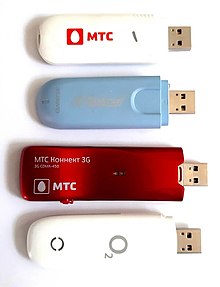Mobile broadband modem

A mobile broadband modem, also known as wireless modem or cellular modem, is a type of
History
1G and 2G
While some
The release of
3G
A further evolution is the
Early 3G mobile broadband modems used the
Often a mobile network operator will supply a 'locked' modem or other wireless device that can only be used on their network. It is possible to use online unlocking services that will remove the 'lock' so the device accepts SIM cards from any network.
Variants
Standalone
Standalone mobile broadband modems are designed to be connected directly to one computer. In the past the
Integrated router
Many mobile broadband modems sold nowadays also have built-in routing capabilities. They provide traditional networking interfaces such as Ethernet, USB and Wi-Fi.[5]
Smartphones and tethering
Numerous
An Internet-accessing smartphone may have the same capabilities as a standalone modem, and, when connected via a USB cable to a computer, can serve as a modem for the computer. Smartphones with built-in Wi-Fi also typically provide routing and wireless access point facilities. This method of connecting is commonly referred to as "tethering."[7]
Service providers
There are competing common carriers broadcasting signal in most countries.
Technologies
- CDMA2000 (3G)
- CDPD
- EDGE
- EVDO(3G, although could be considered to be 3.5G due to its peak bandwidth)
- DC-HSPA+
- GPRS Core Network
- GPRS(2.5G)
- HiperMAN (pre-4G)
- HSDPA(3.5G)
- HSPA+3.75G
- iBurst(pre-4G)
- IP Multimedia Subsystem
- LTE(4G)
- LTE Advanced (4G)
- NR (5G)
- UMTS (3G)
- WiBro (pre-4G)
- WiMAX (pre-4G)
Device driver switching
Mobile broadband modems often use a virtual CD-ROM switching utility and have the device drivers on board. Those modems have two modes, a USB flash drive mode and in the other mode they are a modem. Via the USB Protocol.
See also
- Access Point Name
- Dongle
- EVDO
- GSM modem
- Laptop
- MiFi
- Mobile broadband
- Netbook
- Smartphones
- Terminal node controller
- Tethering
References
- ^ "The Purpose and Use of Broadband Modems in Internet Networking".
- ^ "What is Wireless Modem? - Definition from Techopedia".
- ^ "Vodafone mobile broadband devices". Archived from the original on 2015-09-12.
- ^ "Phone". Sony Xperia (Global UK English). Archived from the original on 1 June 2009.
- ISBN 978-0-470-25889-7.
- ^ Brian Nadel (November 4, 2011). "Wi-Fi tethering 101: Use a smartphone as a mobile hotspot". Computerworld. Retrieved 2012-01-16.
- ^ a b Kim, Eugene and Alex Colon, "The Best Mobile Hotspots of 2015", June 10, 2015, PC Magazine retrieved November 4, 2015
External links
 Media related to Wireless modems at Wikimedia Commons
Media related to Wireless modems at Wikimedia Commons
